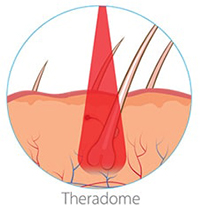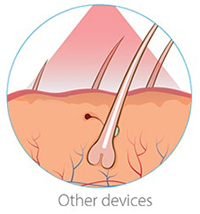LASERS VS LEDS HAIR GROWTH TREATMENTS: WHICH IS BETTER?

Medical Grade LASERS
Theradome contains only medical grade LASERS that penetrate the scalp up to 5mm for maximum follicle stimulation, more than any other at home laser hair growth device.

LED’s
Some laser hair growth products use LED’s. LED beams diverge without reaching the base of hair follicles.
What is Laser Hair Growth?
If you’re among the 50% of Americans who are struggling with hair loss, you’ve likely looked into Low-Level Laser Therapy. LLLT is also referred to as Laser Phototherapy (LPT) and laser hair growth.
After all, it carries a big promise! Laser hair growth treatment has the power to stop hair loss. It also thickens existing hair and grows new hair. Pretty incredible, huh?
It’s no wonder that in the past few years LPT devices have flooded the market. Ideally, these devices provide clinical-strength therapy and results from the comfort of your own home.
For devices that use actual lasers, this is exactly the case. However, a large majority of LPT devices use LEDs (Light-Emitting Diodes) in place of medical grade lasers.
Why do company’s use LEDs?
Many companies choose to either use LEDs exclusively or a mix of lasers and LEDs to cut costs. LEDs are inexpensive and easy to make. That’s why LEDs are often used as on-off indicators in electronic devices. Lasers, on the other hand, produce an intense beam of light and meet scientific-grade standards.
As you might imagine, lasers and LEDs produce very different outcomes when it comes to hair restoration.
To understand exactly how the effectiveness of an LED helmet compares to a laser hair growth helmet, let’s look at how LPT works. There are three key factors where the two differ.
How does Light Therapy for Hair Growth Work?
If you’re experiencing hair loss, it means your hair follicles are no longer functioning optimally. They are not getting the energy they need. This is where your mitochondria come in. Mitochondria are the power plants of your cells. And when they are revived or restimulated, your hair stays intact and new hair can grow.
The challenge is that your hair follicles are deep below the surface. Restoring them requires a precise dose of energy.
Laser hair growth treatments must be able to penetrate your scalp all the way to the hair follicle. This takes the right type of light therapy for hair growth, in the right wavelength, and with enough power.
Here’s how LEDs and lasers differ when it comes to these three metrics.
Light Coherence: Lasers vs LEDs
Lasers emit monochromatic and coherent light, meaning it is a single-color wavelength, and the light waves are in phase.
The single wavelength makes laser light ideal for medical treatments.[1] Certain tissues (including hair follicles) only respond to particular wavelengths of light. Laser light’s coherence keeps the energy focused and the beam narrow. This is so that it can effectively penetrate deeper into the scalp and reach your hair follicles.
LEDs on the other hand, emit light in a range of wavelengths, rather than one specific wavelength. The LED beams are incoherent and wider than a laser’s, so it can’t penetrate as far into the scalp.
Wavelength: Lasers vs LEDs
According to the Swedish Laser Medical Society, 680 nm is the optimal wavelength of light for reaching and stimulating hair follicle cells. Since lasers deliver light at one specified wavelength, they can be targeted specifically for this wavelength.
Because LEDs are neither monochromatic nor coherent, they cannot target this very specific wavelength. Their beams do not actually reach the hair follicle. This makes them therapeutically useless when it comes to hair restoration.
However, it’s important to note that Theradome is the only LPT/LLLT device that delivers the ideal wavelength of 680 nm! Every other LPT/LLLT device uses cheap lasers that are used for DVD’s and CD’s. They are not medical grade lasers as they are used for the consumer electronics industry and NOT for hair growth.
Theradome, however, creates its own lasers right here in Silicon Valley, California specifically to deliver 680 nm wavelengths.
Power: Lasers vs LEDs
The final factor to consider is power. In order to effectively stimulate hair follicles, you need enough energy to reach them to produce a photobiomodulation effect[2].
Well, energy = power X time. And since light becomes more dispersed the farther it travels, you need a significant amount of power for the light to be strong enough once it reaches your hair follicle cells.
Additionally, since energy = power X time, the more powerful the laser, the more energy is produced, and in a shorter amount of time. This means that powerful lasers are not only more effective, they produce results in less time.
Lasers produce far more power than what LEDs are capable of. To put it plainly, LEDs are simply not powerful enough to have a therapeutic effect when it comes to hair growth. To be specific, a laser can deliver about 150 times more joules than an LED. This means deeper penetration and at 680 nm wavelengths, providing even deeper penetration.
Choosing a High-Quality Laser Hair Growth Device
To get real results, with the best outcome possible, always choose a hair restoration device that uses real lasers, never LEDs. And do your research when it comes to wavelength and power. As we just discussed, those two elements are key for effectively stimulating hair growth.
Theradome’s PRO LH80 and EVO LH40 laser hair growth helmets feature high-quality lasers that are created right here in Silicon Valley, California specifically to achieve the optimal 680 nm wavelength. They also deliver the most power (38.4 joules/cm2) of any LPT/LLLT device for maximum hair follicle stimulation and the most breakthrough hair restoration results.
[1] Azadgoli B, Baker RY. Laser applications in surgery. Annals of Translational Medicine. 2016;4(23):452. doi:10.21037/atm.2016.11.51
[2] Knappe, V & Frank, Frank & Rohde, Ewa. Principles of Lasers and Biophotonic Effects. Photomedicine and Laser Surgery. 2004;22: 411-7. 10.1089/pho.2004.22.411.
